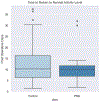Pudendal Nerve Block Analgesia at the Time of Vaginal Surgery: A Randomized, Double-Blinded, Sham-Controlled Trial
- PMID: 37093572
- PMCID: PMC10919352
- DOI: 10.1097/SPV.0000000000001351
Pudendal Nerve Block Analgesia at the Time of Vaginal Surgery: A Randomized, Double-Blinded, Sham-Controlled Trial
Abstract
Importance: Effective opioid-sparing postoperative analgesia requires a multimodal approach. Regional nerve blocks augment pain control in many surgical fields and may be applied to pelvic floor reconstruction.
Objective: This study aimed to evaluate the impact of pudendal nerve block on postoperative pain control and opioid consumption after vaginal surgery.
Study design: In this randomized, double-blind, sham-controlled trial, we enrolled women undergoing pelvic reconstruction, excluding patients with chronic pelvic pain or contraindications to nonnarcotic analgesia. Patients were randomized to transvaginal pudendal nerve block (9 mL 0.25% bupivacaine and 1 mL 40 mg/mL triamcinolone) or sham injection (10 mL normal saline). Primary outcomes were pain scores and opioid requirements. Sixty patients were required to show a 20-mm difference on a 100-mm visual analog scale (VAS).
Results: We randomized 71 patients: 36 pudendal block and 35 sham. Groups were well matched in baseline characteristics and surgery type. Prolapse repairs were most common (n = 63 [87.5%]), and there was no difference in anesthetic dose or operative time. Pain scores were equivalent in the postanesthesia care unit (mean VAS, 53.1 [block] vs 56.4 [sham]; P = 0.517) and on postoperative day 4 (mean VAS, 26.7 [block] vs 35.5 [sham]; P = 0.131). On postoperative day 1, the intervention group reported less pain, but this did not meet our 20 mm goal for clinical significance (mean VAS, 29.2 vs 42.5; P = 0.047). A pudendal block was associated with lower opioid consumption at all time points, but this was not statistically significant.
Conclusions: Surgeon-administered pudendal nerve block at the time of vaginal surgery may not significantly improve postoperative pain control or decrease opioid use.
Trial registration: ClinicalTrials.gov NCT04198714.
Copyright © 2023 American Urogynecologic Society. All rights reserved.
Conflict of interest statement
The authors have declared they have no conflicts of interest.
Figures



References
Publication types
MeSH terms
Substances
Associated data
Grants and funding
LinkOut - more resources
Full Text Sources
Medical
